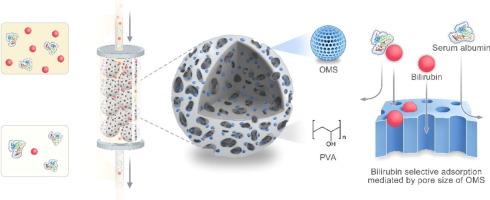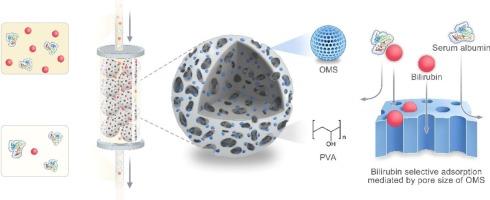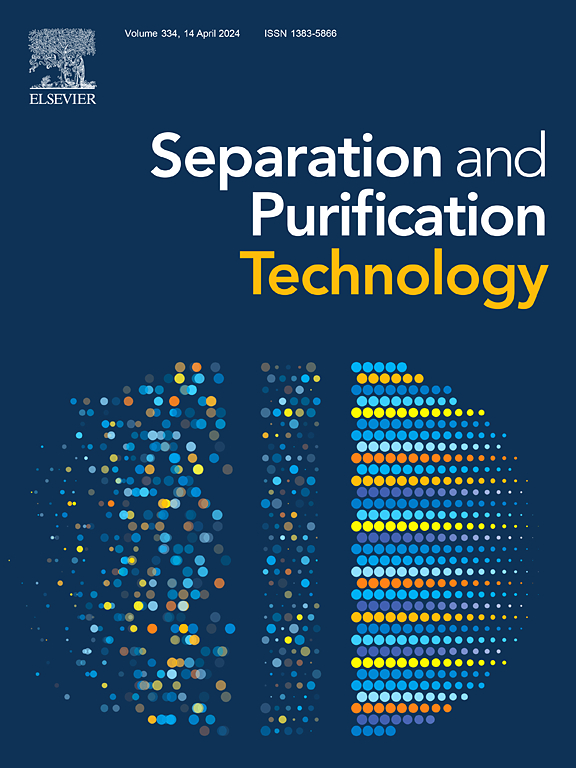Ordered mesoporous SiO2 as hemoperfusion adsorbents for enhanced selectivity of bilirubin removal from blood
IF 8.1
1区 工程技术
Q1 ENGINEERING, CHEMICAL
引用次数: 0
Abstract
Excessive bilirubin poses a significant risk factor in the progression of chronic liver disease. However, due to its nature as an albumin-bound toxin, bilirubin cannot be efficiently eliminated through conventional hemodialysis therapy or existing hemoperfusion adsorbents, presenting a challenge in selective removal. It is widely acknowledged that adjusting the pore properties of adsorbents can impact the adsorption efficiency of a hemoperfusion adsorbent. However, few studies have been working on improving the selectivity of bilirubin removal through precise regulation of pore size. In this paper, we aim to demonstrate that the selectivity of bilirubin removal can be achieved and enhanced by fine-tuning the pore size of ordered mesoporous materials. Ordered mesoporous SiO2 (OMS) is selected as the research object due to its highly organized and uniform porous structure, as well as its excellent biocompatibility. The results indicate that OMS nanoparticles with a pore diameter of 2.5 nm (OMS-2.5nm) exhibit superior adsorption capacity for bilirubin in both pure and albumin-rich solutions, suggesting the potential for achieving efficient and selective bilirubin removal through pore size optimization. Furthermore, to demonstrate the feasibility of OMS nanoparticles in practical applications (i.e. their inheritability of selectivity), we engineered OMS nanoparticles into polyvinyl alcohol (PVA) microspheres, forming OMS/PVA composite microspheres. The incorporation of OMS nanoparticles significantly enhances the bilirubin adsorption capacity of PVA microspheres while simultaneously reducing their albumin adsorption. The excellent selective adsorption efficacy of OMS-2.5nm is preserved in the composite microspheres, underscoring its potential therapeutic benefits for treating diseases with excessive bilirubin levels.


有序介孔二氧化硅作为血液灌流吸附剂,提高从血液中去除胆红素的选择性
胆红素过高是慢性肝病恶化的一个重要危险因素。然而,由于胆红素是一种与白蛋白结合的毒素,因此无法通过传统的血液透析疗法或现有的血液灌流吸附剂有效清除,这给选择性清除胆红素带来了挑战。人们普遍认为,调整吸附剂的孔隙特性会影响血液灌流吸附剂的吸附效率。然而,很少有研究致力于通过精确调节孔径来提高胆红素去除的选择性。本文旨在证明,通过微调有序介孔材料的孔径,可以实现并提高去除胆红素的选择性。有序介孔二氧化硅(OMS)具有高度有序和均匀的多孔结构,以及良好的生物相容性,因此被选为研究对象。研究结果表明,孔径为 2.5 nm(OMS-2.5 nm)的 OMS 纳米粒子在纯溶液和富含白蛋白的溶液中均表现出对胆红素的卓越吸附能力,这表明通过优化孔径大小可实现高效、选择性地去除胆红素。此外,为了证明 OMS 纳米粒子在实际应用中的可行性(即其选择性的继承性),我们将 OMS 纳米粒子加入聚乙烯醇(PVA)微球中,形成 OMS/PVA 复合微球。OMS 纳米粒子的加入大大提高了 PVA 微球对胆红素的吸附能力,同时降低了其对白蛋白的吸附。复合微球中保留了 OMS-2.5 nm 卓越的选择性吸附功效,突出了其在治疗胆红素水平过高疾病方面的潜在疗效。
本文章由计算机程序翻译,如有差异,请以英文原文为准。
求助全文
约1分钟内获得全文
求助全文
来源期刊

Separation and Purification Technology
工程技术-工程:化工
CiteScore
14.00
自引率
12.80%
发文量
2347
审稿时长
43 days
期刊介绍:
Separation and Purification Technology is a premier journal committed to sharing innovative methods for separation and purification in chemical and environmental engineering, encompassing both homogeneous solutions and heterogeneous mixtures. Our scope includes the separation and/or purification of liquids, vapors, and gases, as well as carbon capture and separation techniques. However, it's important to note that methods solely intended for analytical purposes are not within the scope of the journal. Additionally, disciplines such as soil science, polymer science, and metallurgy fall outside the purview of Separation and Purification Technology. Join us in advancing the field of separation and purification methods for sustainable solutions in chemical and environmental engineering.
 求助内容:
求助内容: 应助结果提醒方式:
应助结果提醒方式:


